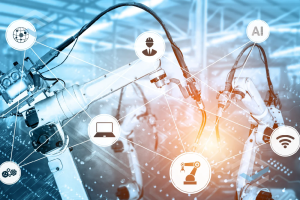Transforming CNC Operations with Industry 5.0 Technologies
The rapid advancement of industrial technologies has significantly altered the landscape of manufacturing operations. While Industry 4.0 revolutionized the integration of digital systems, automation, and data analytics in production, Industry 5.0 represents a more human-centric evolution. In this era, the focus shifts towards integrating collaborative robots (cobots), artificial intelligence (AI), advanced data analytics, and human creativity to enhance the role of human operators in CNC (Computer Numerical Control) operations. This article explores the transformation of CNC operations with the integration of Industry 5.0 technologies, highlighting the enhanced collaboration between humans and machines, the advancement of automation, and the future implications for manufacturing processes.

1. The Human-Machine Collaboration: A Key Pillar of Industry 5.0
Industry 5.0 emphasizes a paradigm shift from the automation-driven landscape of Industry 4.0 to a more human-centered approach. In CNC operations, this means reimagining how human workers and machines collaborate. Rather than replacing human operators, Industry 5.0 aims to augment human capabilities, combining the precision and speed of CNC machines with human creativity, decision-making, and adaptability.
Key Aspects of Human-Machine Collaboration:
- Collaborative Robots (Cobots): Unlike traditional industrial robots, which are often isolated from human workers for safety reasons, cobots are designed to work alongside humans. In CNC operations, cobots can handle repetitive, physically demanding tasks, such as part loading and unloading, while operators focus on complex problem-solving and quality control.
- AI-Powered Decision Support: Artificial intelligence systems integrated into CNC machines can provide real-time feedback and suggest optimizations to human operators. These systems can analyze vast amounts of production data to identify inefficiencies or potential issues, supporting operators in making informed decisions.
This collaboration enhances productivity, reduces downtime, and ensures a safer working environment by minimizing the human workload in physically intensive operations.
2. Advanced Automation and Personalization in CNC Operations
Industry 5.0 brings a new level of automation to CNC operations, one that not only emphasizes efficiency but also enables customization and flexibility in production. This evolution is supported by technologies like AI, machine learning, and big data, which allow for more adaptive, personalized, and efficient manufacturing processes.
Advancements in Automation:
- AI and Machine Learning for Predictive Maintenance: CNC machines equipped with AI-driven predictive maintenance systems can monitor the health of various components in real-time, alerting operators to potential failures before they occur. This reduces unplanned downtime and extends the lifespan of machinery.
- Personalized Production: Industry 5.0 technologies enable highly flexible and customized CNC machining operations. AI and data analytics allow manufacturers to adapt to customer-specific demands quickly, producing unique parts or small-batch orders without compromising efficiency. This flexibility is particularly useful in industries like aerospace, medical devices, and automotive, where customization is crucial.
This shift towards advanced automation not only enhances efficiency but also allows manufacturers to better meet customer needs, offering both high-volume and customized production capabilities.

3. Data-Driven Insights for Enhanced CNC Operations
The integration of big data analytics into CNC operations is another significant aspect of Industry 5.0. Data generated by CNC machines and other production systems are analyzed in real-time to provide valuable insights into operational performance. These insights empower operators and decision-makers to optimize workflows, reduce waste, and increase productivity.
The Role of Big Data:
- Real-Time Analytics: CNC machines, equipped with sensors and IoT devices, collect vast amounts of operational data, including machine performance, tool wear, temperature, and vibration levels. By analyzing this data in real-time, manufacturers can gain insights into the operational efficiency of their machines and make adjustments on-the-fly to prevent downtime.
- Process Optimization: Machine learning algorithms can continuously improve CNC machining operations by analyzing historical data and making adjustments to cutting speeds, feed rates, and tool paths. Over time, these adjustments lead to better quality parts and reduced production times.
Data-driven insights enable manufacturers to adopt a more proactive approach to operations, leading to improved performance, lower operational costs, and better overall production quality.
4. The Future of CNC Operations with Industry 5.0
The transformation of CNC operations through Industry 5.0 technologies is setting the stage for a new era of manufacturing. The integration of human creativity with advanced automation, AI, and real-time data analytics is driving a more adaptive, efficient, and personalized manufacturing environment. As the collaboration between humans and machines deepens, manufacturers will continue to realize benefits such as reduced downtime, increased efficiency, and improved product quality.
Future Implications:
- Flexible Manufacturing Systems: The future of CNC operations will likely see the widespread adoption of flexible manufacturing systems (FMS), where machines, robots, and human workers collaborate in real-time to adapt to changing production requirements.
- Sustainability and Resource Efficiency: Industry 5.0 technologies will also play a key role in promoting sustainability. The use of AI for process optimization can help minimize waste, energy consumption, and material usage, making manufacturing processes more eco-friendly.
- Workforce Transformation: As Industry 5.0 enhances the role of human operators, there will be an increased demand for skilled workers who can operate and maintain sophisticated systems, blending technical expertise with creative problem-solving.
The ongoing transformation of CNC operations with Industry 5.0 technologies promises to revolutionize manufacturing in ways that prioritize efficiency, flexibility, and human ingenuity, ensuring that industries remain competitive in an ever-evolving global market.

Conclusion
The integration of Industry 5.0 technologies into CNC operations marks a critical evolution in the manufacturing sector. By fostering human-machine collaboration, advancing automation capabilities, leveraging big data insights, and creating more adaptable production systems, Industry 5.0 offers a path toward more efficient, flexible, and sustainable CNC operations. As these technologies continue to evolve, manufacturers will be better equipped to meet the demands of an increasingly complex and dynamic global market, while enhancing the role of human creativity and expertise in production processes.








